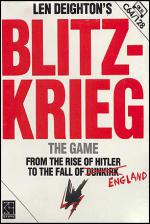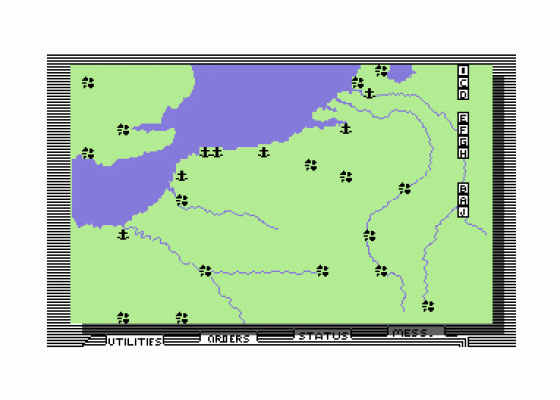
Zzap
 1st October 1987
1st October 1987
Categories: Review: Software
Publisher: Ariolasoft
Machine: Commodore 64
Published in Zzap #30
Blitzkrieg
Blitzkrieg has a wide, sweeping sort of scenario, expressed in its sub-title - 'The game from the rise of Hitler to the fall of Dunkirk', with Dunkirk crossed out and England written above it in crayon. It is immediately apparent that Blitzkrieg is going to be one of those 'change the course of European history on a grand scale' games, and the basic task facing the player is to conquer Western Europe in time for tea.
The game runs from May 1st to September 30th, year unspecified, at which date, apparently, the weather deteriorated; and it is in real time, with each turn taking about fifteen seconds.
There are some strategy games which work with a real time setting, but they are not very many and they really have to be a concept designed around the need for the player to think and move fast. Having seen several real-time wargames which expect the player to rush division counters around as quickly as possible. I have come to the conclusion that no game of this type can be very successful - and in fact they're very often confusing and unplayable. I wonder if designers incorporate real time gratuitously because they feel that computer gamers expect 'game space' action. Arcade games exist in their own self-created fantasy world, and in their own time as well. 'Real time' is a fallacious term; real time for a wargame would be weeks or months. Real time means game time, and by asking a wargame to exist in game time the designer squeezes it unavoidably into being just that - a game. Wargames are games, of course, but unlike arcade games they are supposed to stand for and evoke a reality. And real generals had weeks to make major strategic decisions, and at least a day to choreograph a battle. They certainly did not have to conquer Western Europe in 40 minutes, which is how long the instructions say that a game of Blitzkrieg lasts.
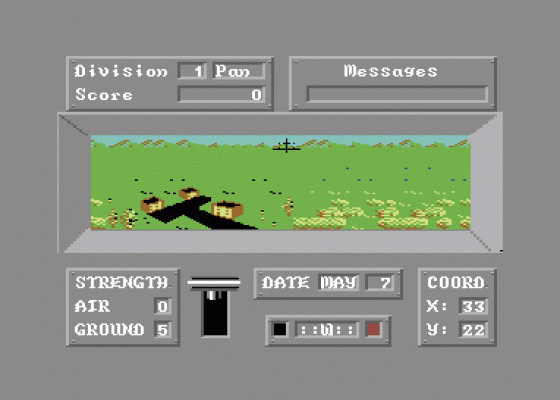
They didn't do it in an afternoon either, but games which allow the player as long as he wants create an illusion of space... however much time they really spend on it.
These are what I would call the psychological and artistic objections to a real time wargame. Blitzkrieg does nothing to overcome them, having a very 'toytown' and unrealistic atmosphere. And it demonstrates a more obvious disadvantage; it's impossible, or very difficult, to keep control of everything that's going on. Wargamers usually only have two hands and one brain, and real time wargamers of this type seem to require them to have several of each.
Blitzkrieg is beautifully programmed and presented, which makes its rapidly apparent unplayability all the more disappointing. The game loads with an optional fast-loader, after a warning that it will only work with 'perfectly aligned' disk drives. I was surprised to find that my disk drive was indeed perfectly aligned, but the loader is certainly fast.
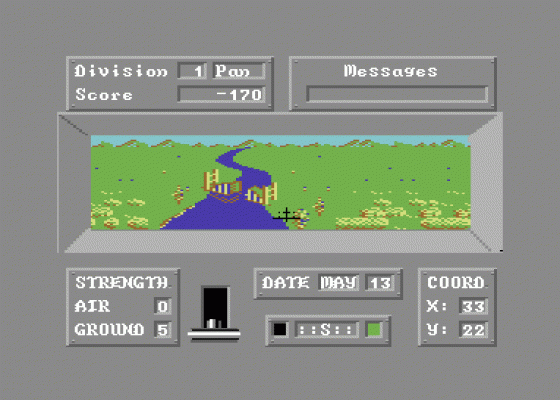
The opening options screen allows the player to spend resource points on altering the initial balance on altering the initial balance of forces, or to view plan diagrams about the weaponry used in the game. Selecting the latter option brings up a series of attractive line drawings and a smattering of information about the tanks, which, although very pretty, does little to compensate for the complete lack of back-up material in the rules.
You can take the easy way in and go for the default set-up, but it is perhaps more interesting to play about with the industrial resource units and build yourself an army. You can choose your own level of IRIs between 100 and 400 and then spend them on division strength, medium and reconnaissance. The allocation of resources is controlled in the form of a letter sent to you as the general, which is the first of many imaginative and individualistic touches in the design. There are four types of division - Air and Ground Panzers and Air and Ground Amphibious - and they can be bought with or without medium tanks, which increase the combat value. The amphibious divisions are important if you have an acquisitive eye on Britain, the conquest of which is of course unhistorical and will earn you 80,000 points. When you've finished the next part of the program loads, without the fast loader this time.
The map is split into two screens, representing the Northwest of Europe and the Southeast of England. There are no features marked on the on-screen map, and the cities look like rabbit's footprints for some reason. Fortunately there is a more informative map on the reverse of the instruction sheet. It indicates the names of cities, shows terrain, and superimposes a grid over Europe for easy reference. When the data card of each unit is examined, the player can pinpoint its position on the more detailed map. In principle this is a good idea, but in practice time seems too precious when you're into the game.
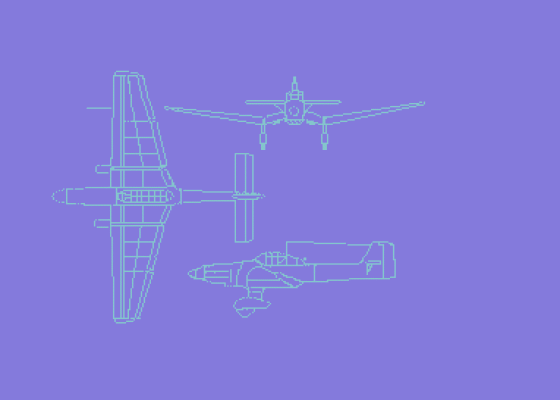
At the top of the screen a counter ticks away the days at the rate of one every fifteen seconds, and at the bottom there is an arrangement which represents a set of index cards. These are pulled-up - literally - by the function keys, and are the menus which drive the game. One gives access to utility options, one to the main command menu, one to the status of the selected unit and one is a file which keeps track of all messages sent to you by the division commanders. This is a lovely piece of design, but despite its originality, one of the game's main weaknesses is caused by this superficially attractive system.
To give a division any sort of orders you have to pull up the appropriate card, and then adjust the commands on it by scrolling through a menu for each part of the order. This is surprisingly and frustratingly fiddly, and quite time-consuming too; first you have to find the number of the unit you want, then the kind of movement order, and then the number of squares you want it to move.
Sending the order drops the card back down, and the process has to be repeated for the next unit. And there can easily be sixteen divisions on the board, all lumbering forward according to their last command and coming across various obstacles. In practice it is not easy to cope with more than a handful at a time, which leaves the rest idle. The game doesn't pause while you're grappling with the order card menus, so every trip of the joystick is another setback to the German Masterplan.
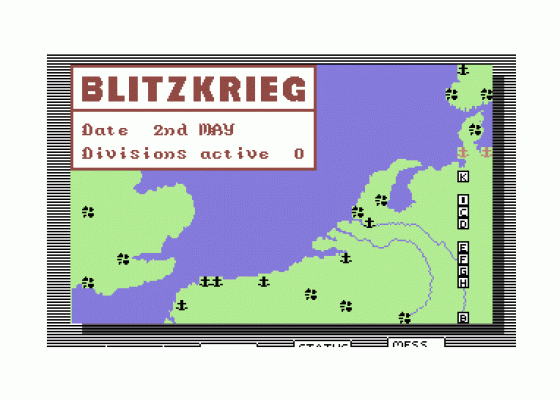
On their progress across Europe the units can run into difficult terrain, which will slow them down or stop them altogether. When this happens, the division commanders send memos - neatly signed with their own names - to explain themselves. It is reasonably difficult to invade the Netherlands because of all the bog about, which brings armies to a standstill.
The way of gaining more detailed information about the terrain in each square is to go into the tactical view, which reminds me strongly of those arcade sequences which sit in the middle of many PSS games in glorious irrelevance. The tactical view puts the player inside a tank, and he can rotate the rights to have a look at the landscape outside and plan his route, or so the instructions say. I found it difficult to make sense of this feature.
Cities are captured by the unit which gets there first, and turned into red, rather than black rabbit's footprints. No enemy units appear on the map at all, though their activities are reported by the division commanders, so the game seems to be little more than a mad dash across the best terrain to take out the cities. Lack of success is abruptly rewarded by Hitler, usually with a bullet in the brain.
This is not a satisfying game. It creates no reality and allows no scope for the exercise of skill, and because of the real time setting it is not particularly playable. The lack of a workable game is all the more regrettable, and noticeable, because of the carefully polished presentation. It's nice to see a wargame so well designed and programmed but the best front-end in the world can't hide an unsound game.
Verdict
Presentation 91% Slick programming, imaginative design, and a printed map to supplement the screen display.
Graphics 88% The screen map itself is rather dull and bland, but the rest of the graphics are very attractive.
Rules 60% Minimal, but functional under the circumstances.
Authenticity 40% Creates no sense of realism - largely because of the 'real time' setting.
Playability 51% The orders system is pretty but unwieldy, and it's difficult to cope with all the units at once.
Overall 55% Disappointing.

